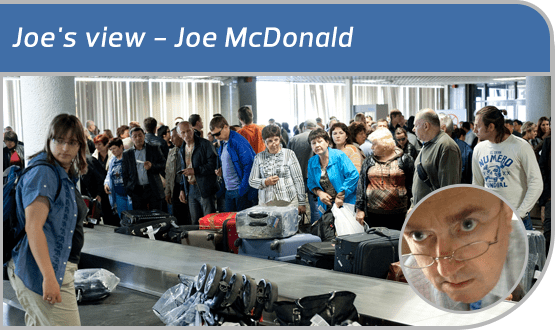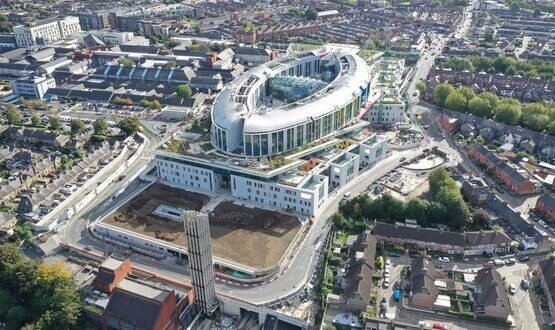Joe’s View: New minister, new vision, new chance to solve an old dilemma?
- 5 November 2018

I watch people. I’ve been doing it for a living for 30 years, and when you’ve watched people for that long it’s hard to stop. When I go on holiday, it continues – though I become less focused on watching individuals and more focused on observing group behaviours.
Most of the behaviour I see is really very good. Queuing to go through the miserable process of airport security is surprisingly well organised and no-one complains or tries to jump the queue. We board the plane in an orderly manner, joining the line when our number is called.
On the plane the people are crammed for several hours into a space they wouldn’t normally tolerate. Yet rather than turning on one another like battery hens, they usually behave remarkably well. By the time the seat belt signs switch off I am basking in the warmth of our shared humanity. Gin and tonic, sir?
Unfortunately this feeling evaporates at the luggage collection carousel. Here we witness everything that is worst about the human condition.
Eager to get on with their holidays, people crowd round the carousel. They press up against it, five deep, and it’s even man for himself. I’ve seen toddlers smashed in the face with suitcases and once saw a woman break her leg in the melee in Geneva arrivals hall.
When I can, I travel hand-luggage only to avoid the descent into the dark ages that is bag retrieval.
The need to act as a collective
Ironically there is a simple solution to this hell. We all just need to take two steps backwards, widening the circle and allowing everyone easy access to the bags and a good view of when you need to step forward. We need to set aside our personal feelings and act as a collective. This is what the sociologists call a “Collective Action Dilemma”.
I have watched the carousel tragedy for years but have only recently had that language to describe it. Though I’m not a student of the NHS Digital Academy, I have been looking over my wife’s shoulder as she is doing her homework. This is how I was introduced to the wonderful Margunn Aanestad, through a 15 minute video which had a grand total of three views when I watched it. You must watch it. I insist.
Margunn explains how she has studied successful interoperability programmes and failed programmes, and then she eloquently explains the difference between them. Success usually starts very small, with clear clinical benefit, few moving parts, a small budget, and benefits delivered quickly.
Failure, on the other hand, has a grand – maybe national – vision, deferred benefits, many moving parts and a big budget. She isn’t actually describing the National Programme for IT but she might as well be.
Cultivating versus constructing
She describes the successful approach as “cultivational” and it to gardening. Prepare the ground, sow the seed, succeed fast, and repeat in a modular manner until you have grown yourself a LHCRE.
She describes the failed method as “constructional” – implementing a central plan at scale and hoping benefits might accrue before people tire of laying the bricks which offer them no immediate benefit.
And so to my own Collective Action Dilemma: the Great North Care Record. The GNCR is a regional shared care record project that has been running for nearly three years and is used 80,000 times a month to provide better safer care for patients.
It uses the Information Sharing Gateway and Medical Interoperability Gateway to make 3.6 million GP records available in secondary care. It is embedded into local EPRs with an easy, in context, launch that makes it “Useful, usable and used” – to quote Matt Hancock’s recent speech at Expo in Manchester.
So far so good. We have built a ‘team of teams’ across the region. A team of CCIOs, a team of CEOs, a team of finance directors, a team of IG leads, a team of CIOs, all agreed on the need for further development of GNCR to transform care in our region. We have built a trusted brand and a remarkable consensus.
We are all agreed on both the long term plan and the next steps. We are all agreed that the next phase involves the deployment of a Health Information Exchange. But here’s the rub. Which one?
A perfect interoperability storm
The GNCR patch is a perfect interoperability storm: a mixed general practice health economy of EMIS and TPP, and in secondary care we’ve got one of everything. You name it we’ve got it. Nobody has the money for ‘convergence’. No-one is going to rip and replace. What’s more, people favour the HIEs which come with their secondary care EPR and are implementing them locally.
So this will be a problem as we develop GNCR, right? Can we persuade everyone to step back from the carousel and pick a single HIE for the region? Maybe, maybe not. But maybe it doesn’t matter because – as Margunn Aanestat points out – successful interop projects are grown not made.
Striking a balance
Local health economies are complex adaptive systems, a concept delightfully explained by in a video from Dave Snowden on how to organise a children’s birthday party. Trust me: you should also watch this. In fact, you must watch it. I insist.
The basic message: no rules leads to an anarchic party with the house trashed. Too many rules equals no fun and therefore no party. The best we can hope for is to strike a balance between the two.
Traditionally the NHS has struggled in the space between ruthless standardisation and allowing 1,000 flowers to bloom. Enter Matt Hancock, the new secretary of state for health and social care, and his initial technology strategy.
This document sets out some high level standards while at the same time driving the market to a new openness, and an agility-based culture that just might succeed.
I know many of you will be sceptical about another new vision for NHS IT, but maybe this time we have a minister who gets it. The cynics are already saying “he’ll be gone in six months, why change?” but I think we need to get behind this vision while we can. This opportunity may not come again.
The question is can NHS England and NHS Digital make the cultural leap required to unleash the power of local development while creating national standards which encourage interoperability? Can they become cultivators rather than constructors? Can everyone just take two steps back so that we can all get to move forward?





7 Comments
ok, rebuild it, buy Business Intelligence, that integrates, aggregates and visualizes (I can recommend Qlik), bye bye for NOW
The teams that really count are the teams of builders, not the teams of managers, leaders, politicians, academics, clinicians … But the teams of people who are building IT, does that make sense ?
No, I’m afraid that doesn’t sound right at all – but I think I know what you mean.
The IT has largely already been built, in umpteen silos using a myriad of standards – it needs connecting together safely, legally and securely. We can’t afford to rip and replace, which is what the National Programme tried and failed to do.
To accomplish that you need the consensus of all the people you listed to agree what the end point needs to be, then to agree the technical requirements and specifications, to agree what standards to use and then to find the money required to design, build, test, implement and sustain the service.
Without all these pre-requisites in place, you’ll end up with an elegant, theoretical, technical solution without the means or the necessary general willingness for it to be implemented. Which is a very frustrating place to be.
Getting anything done in the NHS is like dealing with a very large and very dysfunctional family which is short on money but rich in contradictory ideas about what is needed and how to deliver it.
Are you still on the NHS payroll mate ?
Long story but I retired from the NHS in 2014. I do some contracting, but my main role these days is as a campaigns ambassador and patient advocate for Cancer Research UK and usemydata.org
usemydata.org is all about making better use of patient data, subject to informed consent and appropriate legislation. The latest CRUK campaign is Shoulder to Shoulder Against Cancer – pressing for improvements in NHS diagnostic services.
This morning I’ve been coordinating my own care by telephone. I was scheduled to see my consultant soon about the results of a CT scan, but no-one had actually ordered the scan! This isn’t the first time this has happened. I think this is due to a combination of human error and an inefficient, letter and fax-based referral process between two different NHS Trusts. Just another example of the woeful level of digital maturity across the NHS having a negative effect on patient experience!
Not fair to ask without sharing mine … about £15 per hour, over to U
I’ll PM you 😉
Comments are closed.